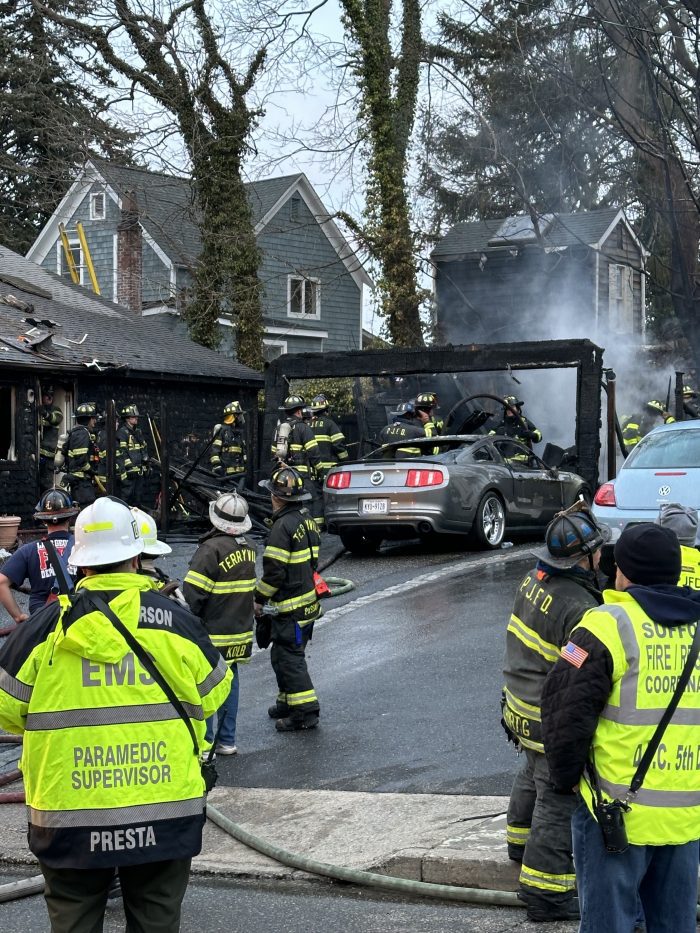By Lynn Hallarman
When Leslie and Priscilla Howard heard they had been chosen, they were shocked and relieved. They knew their pitch to win the farming rights at Cleo’s Corner in Southold was solid. But they also knew the competition was stiff. “We were worried it wasn’t going to happen, a lot of worthy farmers applied,” Leslie said.
A few weeks after receiving the good news in February, the Howards moved into the Case House, a newly renovated historic colonial from the 1700s situated on 5.7 acres of farmable property owned by the Peconic Land Trust. The house was still empty of furniture, but they stayed anyway, sleeping on an air mattress just “to make it feel real,” Priscilla said.
The Case House property is located at the intersection of Horton’s Lane and County Road 48, known as Cleo’s Corner. Across the road, lies another stretch of farmland also owned by the Peconic Land Trust. This land is leased to aspiring farmers as part of their Farms for the Future program. The Howards are recent graduates of the program. Priscilla’s Farm, a project they began together in 2018 on a single acre as part of the program, is now being recast as the Case House location as a fully operational, certified organic vegetable farm. Priscilla’s Farm has a community-supported agriculture pledge now with 30 members and sells directly to the public at the Port Jefferson and Sayville farmers markets.
Farms for the Future
Growing vegetables is easy, selling them is hard, according to Dan Heston, director of agricultural programs at the land trust and leader of Farms for the Future. It’s the infrastructure demands — fencing, water access and equipment — that derail farming ventures, he explained. “You also need a solid business plan,” he said. “Just because you grow it doesn’t mean you can sell it.”
Heston helped launch Farms for the Future in 2009. The program offers emerging farmers technical assistance and affordable land leases. “Everyone starts with one acre,” he said. “An acre is a lot bigger than most people realize.” Participants have five years to expand their farms, adding acreage and crop variety. The program also created a cooperative for equipment rentals, and assists with field layouts, irrigation systems and tractor operation — resources that are hard to master without guidance. “This is not a gardening program,” Heston said. “We’re trying to find the next generation of farmers.”
The program encourages, but doesn’t require, participants to farm food or organics. “We support all kinds of agriculture — wine, sod [grass], nurseries — but we give more help to food growers, because it’s harder,” Heston said. According to him, Farms for the Future has 32 leases covering 400 acres run by farmers of all ages and backgrounds. “We have a lot of women farmers,” he added.
After five years, farmers are expected to move on from the program to expand their businesses. “Nobody gets kicked out but you have keep people moving, otherwise it wouldn’t be a program anymore, it will be stagnant,” Heston said. He estimates that 90% of farmers who go through the program continue doing something that relates farming. “Just not always going on to running their own farm,” he said.
A more complicated piece of the program is land acquisition. The trust buys, protects and sells farms with a verve associated with saving endangered species habitats. The strategy involves selling the development rights of a farm to local governments and then applying an easement that prioritizes food production. “Farmers pay a fair rate, we’re not looking to make money,” Heston said. This approach makes the land affordable for food farmers either to purchase or to lease from the trust.
The Case House project is a recent example of the trust’s mission to combine affordable housing for a farm family ready to run a larger operation. Heston, who has farmed his whole life, wanted the property to be set up for somebody to be successful. And the land trust predicted that the Howards would be a perfect fit. “They were ready to move on to the next phase about the time we finished renovating the Case House,” he said.
Food farming in Suffolk County
Organic vegetable farming in Suffolk County is its own microcosm, existing on the margins of the agro-industry that is itself subject to a tangle of state and local regulations, competing interests and the constant pressure to rebuff development. Navigating it all can be daunting and expensive. In Suffolk County there are currently 20 organic certified farms, according to the U.S. Department of Agriculture. Organic vegetable farming is particularly ephemeral, and cultivating high-quality soil and crops can take years.
Harder to know is how many of these farmers are sustaining profit margins big enough to stay in business for the long term. Larry Foglia, an executive committee member of the Long Island Community Agriculture Network and himself a farmer for decades, noted that for some farmers sticking with vegetable farming, organic or conventional, is an impossible choice in a marketplace where sod, for instance, offers real profit. He believes that soil preservation is key to sustaining the organic industry in Suffolk — “my soil is like chocolate cake, I have been building it for 60 years” — and in recent years has focused on educating the public about this issue.
Growing Priscilla’s Farm
As it happens, vegetable farming is Leslie Howard’s secret superpower. He is 50 and when he gave me a tour of the farm, his face hidden by a baseball cap and a reddish beard, his strides were hard to keep up with. He has a calm competence built on years of tinkering with growing techniques, and his opinions about organics come across as missionary, but without the arrogance or bluster. “We never lay down plastic sheeting to suppress the weeds — we could, but we don’t,” he said emphatically. Howard loves soil and water, and old farm machinery. He pointed to his 1949 Allis-Chalmers tractor. “We got it for free and it is easy to fix,” he said.
Howard is a descendent of the Wells family, whose farming roots in Suffolk County date back to revolutionary times. Although Leslie Wells, Howard’s great-grandfather, was the last of his family line to farm, Howard believes farming is “in my blood.” After spending over a decade as a winemaker for local vineyards, he decided to transition to food farming when a series of personal and health events left him feeling burnt out with the wine industry. Then, in 2016, he met Priscilla.
What began as a chance encounter while working on the same organic vegetable farm quicky blossomed to romance, and in 2017 they married. Starting an organic vegetable farm together was a natural next step.
For Priscilla Howard, 46, a gardener and vegetable grower her whole life, realizing she was a farmer took years. She spent her 20s and 30s raising two children and working in the public school system teaching social studies. What ultimately drew her to take the plunge into farming was the challenge of figuring out the magic of growing, turning that into a plan to earn a living — and being outside while doing it.
Priscilla has showstopping green eyes and a schoolteacher’s penchant for listening. Together the couple can come across like characters from a Tolkien novel — he working wizardry, she earthbound and observant. While Leslie described the intricacies of organic pest management, Priscilla wandered among rows of newly-sprouted beans, digging up remnants of plastic sheeting left by the previous tenant.
“It’s a labor of love for us and we like the lifestyle. We just need to make enough that we can support ourselves,” Leslie Howard said, adding, “And we really like to eat fresh food.”


















